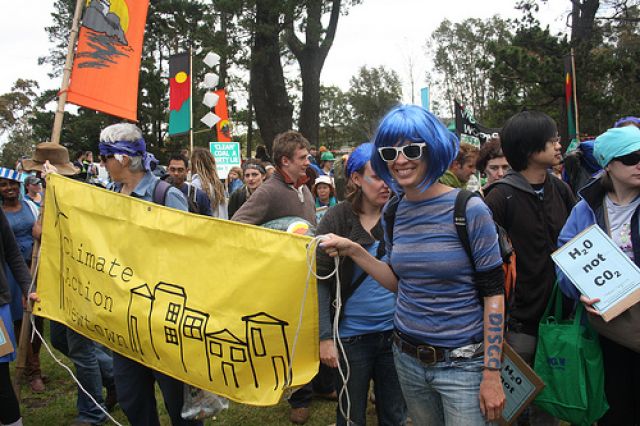
One of Australia’s biggest carbon emitters, Bayswater coal-fired power station in the Hunter Valley of NSW, will be the target of this year’s Camp for Climate Action.
Over December 1-5, the camp will bring people from around the country to a site near Bayswater, and will culminate in a mass protest against the proposed expansion of the power station.
The proposed new coal-fired power station, known as Bayswater B, would produce 12.4 million tonnes of carbon dioxide a year. Combined with emissions from a second proposed new coal-fired power station at Mt Piper, this would represent a 34% increase in emissions from stationary energy in NSW, according to Nature Conservation Council of NSW.
Prime Minister Julia Gillard’s carefully worded pre-election announcement that her government would ban new “dirty” power stations does not apply to Bayswater B or the other 12 new coal-fired power stations already proposed in five states across Australia.
When the state government gave “concept approval” to Bayswater B in March, planning minister Tony Kelly said it was yet to be decided whether the power station would run on coal or gas. The latter option would still produce almost 5.9 million tonnes of carbon dioxide.
The climate camp website says: “It’s seems unbelievable that at a time when the world understands the urgent need to radically cut greenhouse pollution, and at a time when we know 100 percent renewable energy is possible, this reckless expansion of coal infrastructure is underway.”
A report recently completed by independent research organisation Beyond Zero Emissions (BZE) modelled and costed the introduction of 100% renewable energy within the next 10 years.
Launching the plan, BZE executive director Matthew Wright said it focused on technologies that were already commercially available, such as wind and large-scale solar thermal.
“The inherent design of a solar thermal plant is that it stores its heat away for night time. We've modelled that, from our 12 solar regions across the country and our 23 wind sites, we get 100% of our power needs, 365 days a year, 24 by seven”, he said.
In 2008, more than 500 people camped in Newcastle for Australia’s first Camp for Climate Action, and more than 1000 joined a peaceful direct action that shut down the coal rail line into the world's largest coal port for a day.
In 2009, camps took place around the country targeting coalmines and coal-fired power stations in NSW, Victoria, South Australia and Western Australia.
This year’s camp is planned to coincide with the United Nations global climate change talks in Cancun, Mexico. By drawing attention to coal-fired power, the camp aims to send a message that people will not tolerate further inaction from governments. The camp will demand a “just transition” to renewable energy, a transition away from dirty power that doesn’t adversely affect workers in that industry.
A stimulating program of workshops and forums about climate change and solutions will be run at the camp in the lead-up to the mass peaceful action on Sunday December 5.
[To find out more, visit www.climatecamp.org.au .]